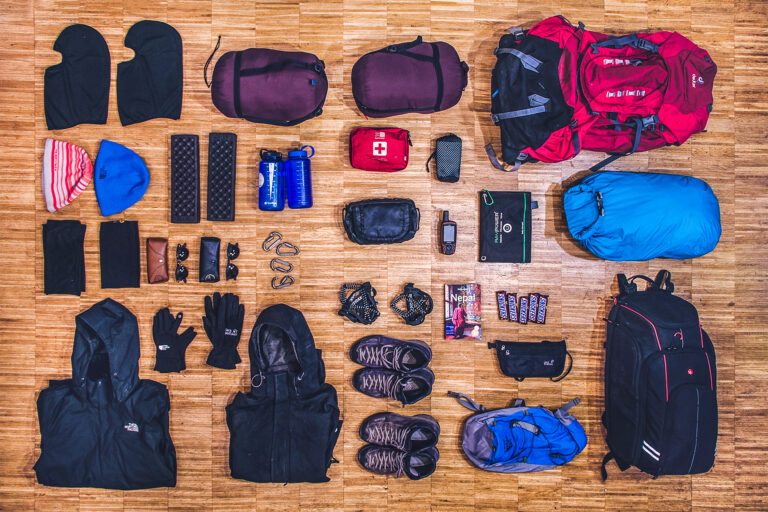Trekking to Everest Base Camp is a dream for many adventure seekers, offering breathtaking views, unique cultural experiences, and the challenge of conquering one of the world’s most iconic trails. However, the success of your journey largely depends on your preparation, particularly your packing strategy. With fluctuating temperatures, diverse terrains, and the potential for unpredictable weather, having the right gear is crucial. This guide will provide a detailed packing list for your Everest Base Camp trek, along with essential tips to ensure you’re fully prepared for the adventure of a lifetime.
Why a Comprehensive Packing List is Essential
Embarking on the trek to Everest Base Camp is not just about reaching a destination; it’s about experiencing the journey. A well-thought-out packing list helps you:
- Stay Comfortable: The right clothing and gear can significantly enhance your comfort level.
- Be Prepared for Weather Changes: The Himalayan weather can be unpredictable, requiring layers and specific items to keep you safe.
- Ensure Safety: Proper equipment and first-aid supplies can be lifesavers in remote areas.
- Avoid Overpacking: A focused list prevents you from carrying unnecessary items that can weigh you down.
Understanding the Trek to Everest Base Camp
Before diving into the packing list, it’s important to understand the trek itself:
Trek Overview
- Duration: Typically 12-14 days, depending on your itinerary.
- Altitude: Base Camp is situated at 5,364 meters (17,598 feet).
- Difficulty: Moderate to challenging, depending on your fitness level and experience.
- Weather Conditions: Temperatures can range from -10°C (14°F) at night to 20°C (68°F) during the day, depending on the season.
Best Time to Trek
The ideal months for trekking to Everest Base Camp are:
- Spring (March to May): Warm temperatures and clear skies, but it can be crowded.
- Autumn (September to November): Cooler temperatures and fewer trekkers, but the risk of rain increases.
Everest Base Camp Packing List
Clothing
Layering is key when trekking in the Himalayas. Your clothing should be breathable, moisture-wicking, and provide insulation against the cold.
Base Layer
- Thermal tops (2-3): Lightweight, moisture-wicking materials to keep sweat away from your skin.
- Thermal bottoms (2-3): Long underwear that provide warmth.
Middle Layer
- Fleece or wool jackets (1-2): Insulating layers for warmth without bulk.
- Long-sleeve shirts (2-3): Quick-dry fabrics for day hikes.
Outer Layer
- Waterproof and windproof jacket (1): Essential for protection against rain and wind.
- Insulated down jacket (1): Lightweight and packable for extra warmth at high altitudes.
- Waterproof trekking pants (1 pair): Keeps you dry during rain or snow.
- Hiking pants (2-3 pairs): Comfortable and durable pants for trekking.
Footwear
- Trekking boots (1 pair): Sturdy, waterproof, and well-broken-in boots for support and traction.
- Camp shoes or sandals (1 pair): Comfortable footwear for relaxing at tea houses.
- Hiking socks (5-7 pairs): Wool or synthetic blend, ideally with cushioning and moisture-wicking properties.
Accessories
- Warm hat (1-2): Covers your ears and provides warmth.
- Sun hat or cap (1): Protects from the sun during daytime hikes.
- Gloves or mittens (2 pairs): Insulated and waterproof for cold weather.
- Buff or neck gaiter (1): Protects your neck and face from wind and cold.
- Sunglasses (1 pair): UV protection is crucial in high altitudes.
Toiletries and Personal Care
- Travel-sized shampoo and conditioner: To keep your hair manageable.
- Biodegradable soap: Environmentally friendly option for washing.
- Moisturizer: To combat dry skin from altitude and cold.
- Lip balm with SPF: Protects lips from sunburn and chapping.
- Toothbrush and toothpaste: Keep your dental hygiene in check.
Gear and Equipment
Depending on your trekking style, consider these items:
- Daypack (1): A comfortable, lightweight pack for day hikes, ideally 20-30 liters.
- Sleeping bag (1): Rated for temperatures down to -10°C (14°F) for warmth at higher altitudes.
- Trekking poles (1 pair): Helps with stability and reduces strain on your knees.
- Headlamp or flashlight (1): Essential for navigating at night.
- Water bottle or hydration system: Staying hydrated is critical at high altitudes.
- Water purification tablets: Ensures safe drinking water during the trek.
Electronics
- Smartphone and charger: For navigation and communication (consider a power bank).
- Camera: Capture the stunning scenery.
- Portable charger: Keeps your devices powered during multi-day treks.
- Adapter and extra batteries: For electronic devices.
Miscellaneous Items
- Reusable snack bags: For trail snacks like nuts, dried fruits, or energy bars.
- Travel guidebook: Helpful for cultural insights and trekking tips.
- Laundry bag: Keep dirty clothes separate from clean ones.
- First-aid kit: Include items like band-aids, pain relievers, blister treatment, and any personal medications.
Tips for Effective Packing
Organize Your Luggage
- Use Packing Cubes: They help separate clothing and gear, making it easy to find items.
- Roll Your Clothes: Saves space and reduces wrinkles.
- Prioritize Essentials: Keep your most-needed items at the top or in easy-to-reach pockets.
Prepare for the Journey
- Wear your heaviest items: If possible, wear your trekking boots and jacket during travel to save luggage space.
- Pack for your flight: Check airline regulations regarding baggage size and weight, especially for domestic flights in Nepal.
Stay Flexible
Be prepared to adjust your packing list based on personal preferences, current weather conditions, and the specific requirements of your trek.
Conclusion
Trekking to Everest Base Camp is a once-in-a-lifetime experience that demands careful preparation. By following this comprehensive packing list and considering the tips provided, you can ensure that you are well-equipped for the challenges ahead. The right gear will not only enhance your comfort but also keep you safe as you navigate the stunning, yet rugged terrain of the Himalayas.
Remember, the journey is just as important as the destination. Embrace every moment, from the crisp morning air to the awe-inspiring views, and make unforgettable memories on your trek to Everest Base Camp.

